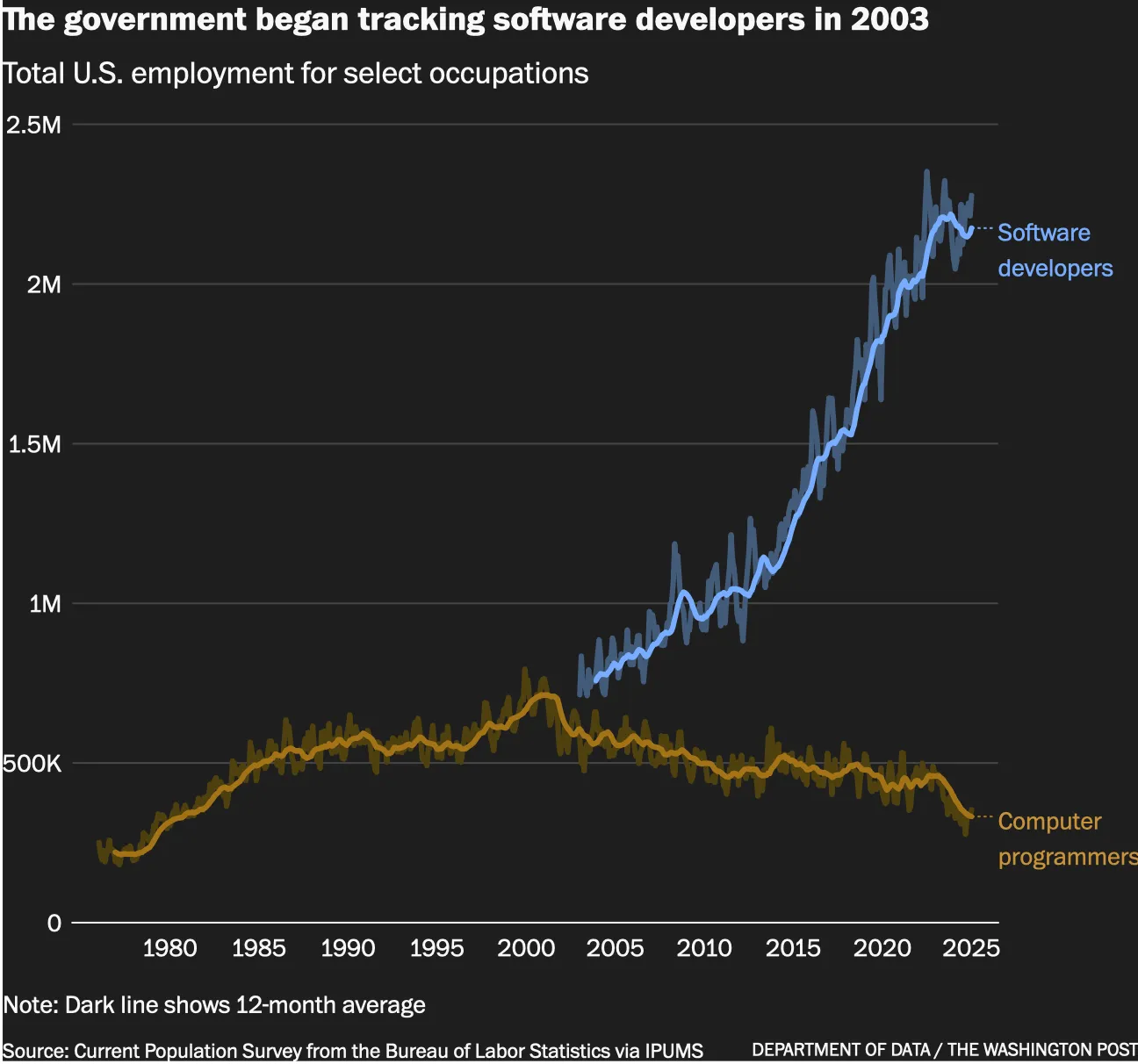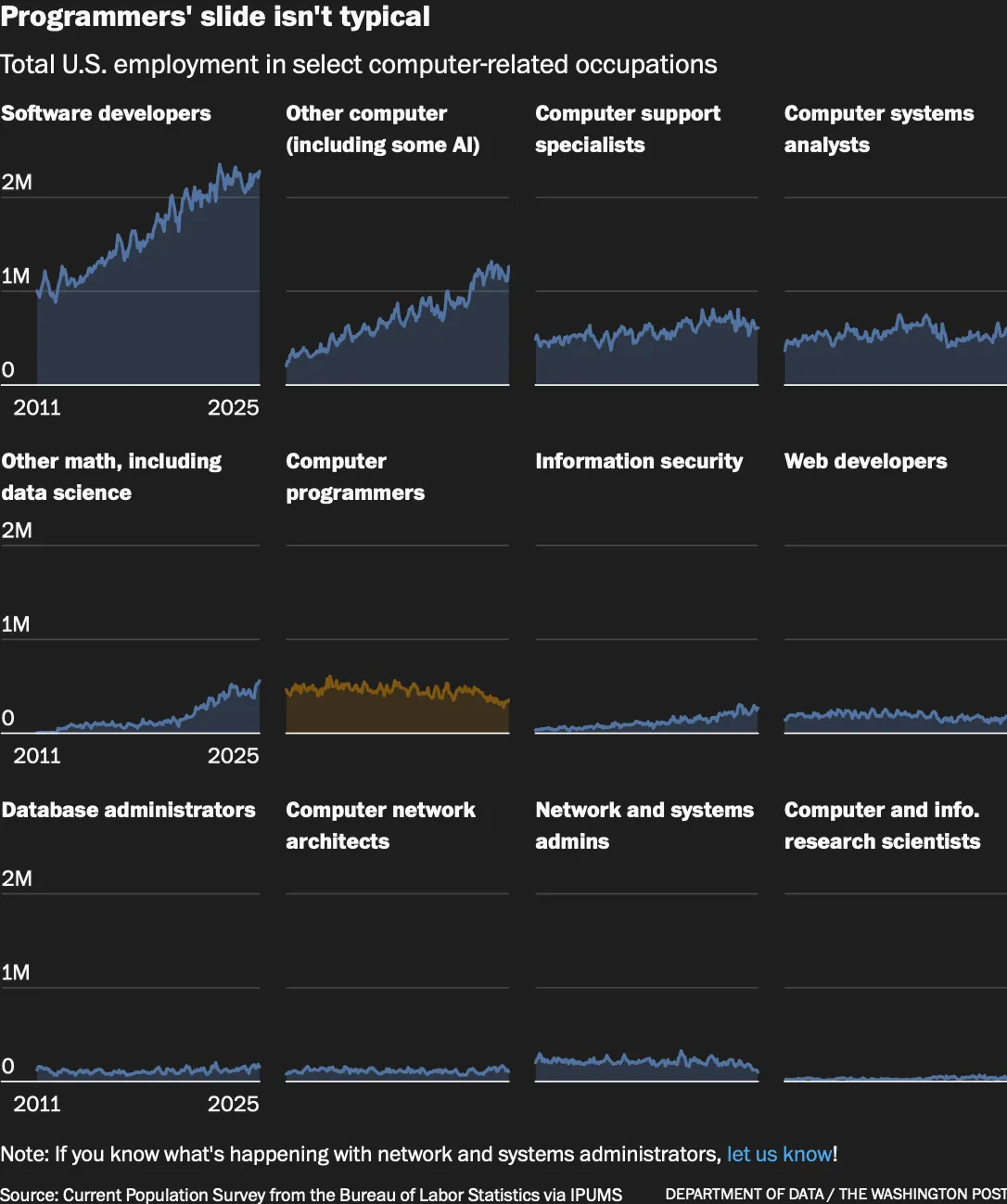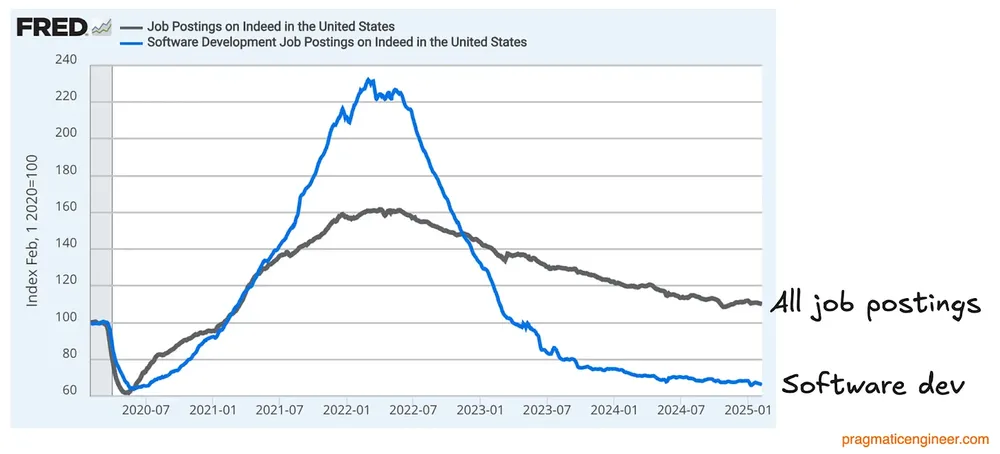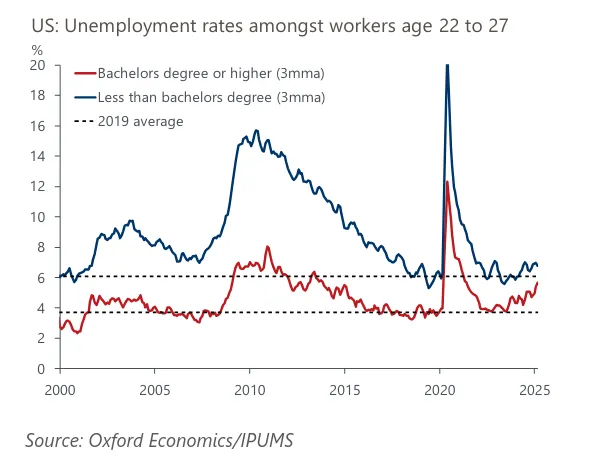# The AI-Safe Career 1: Developer Jobs
Table of Contents
When GPT-3 was announced in May 2020, the world of software development changed forever.
At least, that’s what several 2025 headlines and big companies are implying1. The reality is that the perception of the impact of LLMs has been much greater than the actual impact of LLMs: they’re complex tools that capture the imagination.
In this series of articles, we will look at available data and expert analyses2 to address the fears and misconceptions, by focusing on one aspect at a time.
Is AI taking developer jobs?Link to heading
There’s enough confusion about the current state of the market, that it’s worth addressing as the first topic. Let’s start by dividing the question into smaller ones we can answer more confidently.
Are software developer jobs declining?Link to heading
Different data sources have different definitions for software developers, what a job is, and in which location. This gives us an idea of general trends, but be wary when comparing figures.

This is a good illustration of the definition problem: in 2003, the U.S. Bureau of Labor Statistics (BLS) started tracking programmers and developers as different jobs. This leads to vastly different curves, with no clear distinction in categorization.
The point of that graph is not that a certain kind of developer is on their way out, but that data needs to be interpreted with context.
The Washington Post also provided graphs with a breakdown of software workers, which paints a clearer picture:

Note that it’s a different timescale: 2011-2025. Most of those categories have been stable throughout, with little impact from the release of LLMs or even inflation. The BLS even projects a “Much faster than average employment growth” for software developers, which is great news.
There’s other sources indicating the same pattern:
There are 485k businesses in the IT Consulting industry in the United States, which has grown at a CAGR [Compound Annual Growth Rate] of 1.7% between 2020 and 2025.; IBIS, 2025
— IT Consulting in the US - Market Research Report; IBIS, 2025
Europe Job Growth CAGR [Compound Annual Growth Rate]: 6.4% [employees]
— Software Development in Europe - Market Size, Industry Analysis, Trends and Forecasts; IBIS, 2025
[…] ICT specialists in employment in the EU generally held out against the effects of the global financial and economic crisis […]
— ICT specialists in employment; Eurostat, 2025
[…] increased by 62.2% during the period from 2014 to 2024, […]
[…] 4.3% between 2022 and 2023 and 4.8% between 2023 and 2024
It’s completely fair to be skeptic of picking 2020 as the start date for reference of growth, because other events (COVID) had a stronger impact on the market than the announcement of GPT-3. The next sections should address that.
Going by high-confidence BLS data, the U.S. had 1,656,880 employed Software Developers in May 2023, against 1,654,440 in May 2024. That’s a 0.1% 1-year decline, within the 0.7% margin of error. Stable in absolute terms, but unusual compared to the typical growth of around 1-5%. There is a reason for that, and it will be evident soon.
Why securing a job feels tougherLink to heading
Despite employment being stable, there’s much anecdotal evidence that finding a software job feels tough. Why is that?
This is a measurable effect, not just anecdotal:
78% of tech leaders struggle to find candidates, just as 74% of developers struggle to land jobs.
— HackerRank Developer Skills Report 2025, Insight 6
This source appears biased: HackerRank is where many developers practice for interviews, so it might be obvious that people on the platform are having trouble finding jobs.
Yet those numbers are in line with other available data:
74% of employers say they are struggling to find the skilled talent they need. […]
— Global Talent Shortage; ManpowerGroup, October 2024
76% [in] Information Technology
as of September 2024, the median unemployment duration was about 10.7 weeks (2.5 months) […] closer to 6 months in tech-heavy sectors
— Average Job Search Time for Tech Roles in the U.S. (2024–2025); Anotnio Montano, April 2025
The U.S. “computer and mathematical occupations” unemployment rate3 was 2.8% in 2024, impressively lower than the 4.1% national unemployment rate: the jobs are there.
It may be partially explained with employment statistics for new developers, as we’ll see later, but a more comprehensive answer involves supply and demand:
65% of the number of [U.S. software] vacancies in January 2020 (a 35% decrease!)
— Software engineering job openings hit five-year low?; The Pragmatic Engineer, 2025
The missing piece is demand in the job market. Even though software jobs haven’t gone down, job postings have. The supply of aspiring developers has kept growing, outpacing the demand. When there’s more supply (developers) than demand (job postings), employers get to be more picky about who they choose.
We developers have been used to a candidate’s market (very high demand) for over a decade. We’re now encountering a period of higher resistance (lower demand) for the first time in a long while, it makes sense that it would seem tough.
But that’s not the full story. As hinted by the HackerRank report, employers are also struggling to hire developers, meaning there are enough vacancies, and the problem lies elsewhere:
In 2023, 57.5% of EU enterprises that recruited or tried to recruit ICT specialists had difficulties in filling ICT vacancies. […]
— ICT specialists - statistics on hard-to-fill vacancies in enterprises, 2025
With 43.24% the lack of applications was the difficulty for filling ICT specialists’ positions most often faced by enterprises in 2023
Lack of applications is, surprisingly, a high share of the problem. Broken hiring practices are also anecdotally a big share of the problem, you hear stories like these very4 often:
A perfect ATS score doesn’t guarantee a human will ever look at [your job application]. […]
— The Untold Reality of Job Searching in 2025: A Personal Story; Pushpender Bhandari, 2025
The position is already filled internally. […]
[Cover letters] work only when a human … reads your application. […]
It’s a numbers game with patience, persistence, and a bit of luck. […]
Many [recruiter] calls are … to show clients they have a “pool,” […]
friends or connections may find it difficult to push referrals.
up to 21% of job ads may be ghost jobs
— Why is it so hard to find a job now? Enter Ghost Jobs; Hunter Ng, Oct 2024
Is AI behind the dip?Link to heading
Reputable analyses are almost unanimous on this one:
Interest rate changes explain most of the drop. […]
— Software engineering job openings hit five-year low?; The Pragmatic Engineer, 2025
[Interest rate changes affect] many things across the economy since 2022, including hiring, the steep fall in VC funding, and how many tech startups survive, thrive, or die.

The same article also explains why and how COVID and COVID-related interest rate policy changes have been so impactful on it: both in a booming growth until 2023, and the fall after.
You can see a similar conclusion with different data/metrics, by a different team:
Before the pandemic, software developer salaries grew faster than average. That changed when the Covid-19 recession ended.
— The rise—and fall—of the software developer; ADP Research, 2024
Unlike the previous sources, the ADP article suggests a continuous employment loss since 2020 based on independent data, but also declares AI a non-factor.
You can find plenty of articles predicting mass replacement in the future, many implying it’s already happening which is verifiably false. They rely on anecdotes and sensational speculative claims, without supporting research.
They often cite new developers, whose opinions -which they are entitled to- are generally uninformed and exaggerated; and CEOs, who have it in their best interest to make a bad and boring trend (inability to maintain personnel due to unfavourable economy, and/or bad/impulsive management) look like a good and exciting event (cost-cutting via AI will bring stocks up).
A good rule of thumb is that when you read them, if you don’t have the time or attention span to check every source, at least check that there are external and somewhat reputable sources.
We have pretty good explanations for what happened until now, but predicting the future is more complex and will be tackled in separate articles.
As an early reassurance:
when developers use AI tools, they take 19% longer than without—AI makes them slower. […]
— Measuring the Impact of Early-2025 AI on Experienced Open-Source Developer Productivity; METR, 2025
even after experiencing the slowdown, they still believed AI had sped them up by 20%.
This is one study of several, but there’s varying results. We’ll discuss that more in the relevant article.
Because future articles will be mostly focused on AI, and I’ve already stated AI is not the problem with demand right now, here’s a short aside on what non-AI causes mean for the future:
The Beveridge curve illustrates the relationship between job openings … and unemployment rate […]
— How Have U.S. Workers Fared in a Labor Market Reshaped by the Pandemic?; Federal Reserve Bank of St. Louis, 2025
the overall [U.S.] job match relationship returned to its prepandemic position.
The article above is not specifically about software development, but illustrates what is generally happening to jobs post-pandemic, and software development so far is following similar trends. In short, things are returning to normal.
As for tech specifically, here are my reasons for why I speculate a favourable balance will re-emerge:
- The field is maturing: long-term-expensive but short-term-cheap broken hiring practices will be fixed
- Demand is already showing signs of rebounding and will keep growing: tech as a whole is not slowing down
- Supply will lag behind by a few years, but adapt: e.g. those scared of AI will drop out, leaving more jobs for everyone else.
Are dev jobs distinctly affected by AI?Link to heading
Another way to see whether AI has been replacing software jobs, is by comparing employment trends with careers that are expected to be less affected by AI. So let’s have a look.
AI exposure is defined as overlap with human capabilities, regardless of effectiveness. Software Development has very high AI exposure, although that doesn’t mean it is or will be automated.
Read more about AIOE
Although the unemployment rate for the most AI-exposed workers is indeed rising, it is actually rising even faster for the least exposed workers. […]
— AI and Jobs: The Final Word (Until the Next One); Economic Innovation Group, 2025
It doesn’t look like workers more exposed to AI are changing occupations more than they used to.
If you’re having trouble making sense of it, keep in mind that correlation is not causation. A likely explanation is that there’s forces at play that have much stronger impact than AI, and the cards are laid out such that AI-exposed careers are less negatively impacted by those forces.
If you wanted to look for possible AI causation instead, consider what software development is, at its core:
Why do we want programs developed? To make a computer perform a task that would otherwise be assigned to a slower, less consistent, and more expensive5 human.
We are automation: employers hire a developer to make a webpage that can be served to millions of people per day, instead of hiring a printing company and tens of thousands of delivery workers.
We are near the top of the food pyramid of jobs. I don’t like that the pyramid exists, but it is in our favour6.
Bonus: how helpful is a degree?Link to heading
There’s many arguments in favour and against heading into software via university. This section is only concerned with finding jobs in this dip of lower demand, regardless of whether AI is behind it, or other factors like salary.
The charts and data below are for all US industries, but computer science is cited as a major factor in all of them.

While the unemployment rate for those aged 22-27 with less educational attainment has drifted higher, […] the unemployment rate for recent college graduates has risen [more]
— Educated but unemployed, a rising reality for college grads; Oxford Economics, 2025
The wording is not obvious nor conclusive for computer science specifically, but the chart shows how much better off you would be with a degree.
The report points out that it’s a particularly tough time for new entrants in any field. If you’re one of them, you might want to give it a read.
In line with the AI-exposure section above, there’s some relevant data for graduates:
recent college graduates majoring in accounting and education see unemployment rates below 2%
— The Labor Market for Recent College Graduates – Part 1: No More Jobs?; Encoura, 2025
2% graduate unemployment is very low, so accounting (a field with high AI exposure) could be a good place to go if you were seeking alternatives. Just keep in mind it’s in the bottom 6% of careers by satisfaction.
ConclusionLink to heading
AI hasn’t had noticeable impact on software developer jobs.
So far AI is a non-issue, but how about the future? Next up, we’ll look at whether AI has been boosting software developer productivity, and give projections for the future.
On top of my over 10 years of experience in the field, this post took approximately 50 hours to research and write. If it captured your interest, check out yourweekly.dev: a service for aspiring and professional developers.
footnotes
FootnotesLink to heading
-
I will allude to other less reputable articles, but won’t link to them. They’re easy enough to find on google, without the extra SEO. ↩
-
Most of the references will be for US/EU, because that’s what we find most data/analyses for. These are reasonable indicators for global trends, at least for the countries where this article is legal to read. ↩
-
Some question the effectiveness of unemployment statistics, because it’s “based on unemployment benefit collection”. That’s not the case for BLS data: https://www.bls.gov/cps/cps_htgm.htm#where. Another metric to consider is the participation rate, showing that the number of US job-willing-and-able people is only roughly 1% below pre-covid numbers: https://fred.stlouisfed.org/graph/?g=1hY50 ↩
-
Note that this is from 2023, meaning that when demand was at its peak, higher than before covid, finding a job was still unnecessarily tough. ↩
-
financially speaking. The price of human labour is not only salary, but also benefits, taxes, hiring, training, and HR/managers. There’s metrics in which it’s the other way around, such as energy consumption, but that’s not the primary concern of businesses. ↩
-
until there’s nobody left to buy what we’re developing, of course. There must be a balance. This occupational pyramid is only in our favour in relative terms: if we get to the point where corporations don’t respect the balance and economies collapse, we will feel it. But so will everybody else. ↩